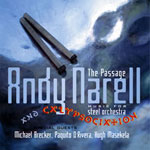
Steel Pan Alley
|
This review first appeared in the Spring 2004 issue of Turbula.
It's an odd thing that the best-known (at least in the States) individual player of the Trinidadian steel drum is a white guy from the Bay Area. The overwhelming influence of American culture, perhaps. Or maybe it's the fact that nobody has ever tried to do more with a steel drum than Andy Narell. From straight-ahead jazz to new age, world beat to easy listening, Narell has taken the steel pan places it would never have been otherwise.
What sets Narell apart from most steel drum players is that he's never played with a traditional Caribbean approach. Narell has always played his instrument like an American – no false hip attitude, no attempts to affect a patois. Instead, he plays steel drum like he would a saxophone or piano - his influences are jazz, primarily, and then just about every other popular style of the past half-century, from rock to Latin to classical.
Narell also has an individual sound on the pans that makes him instantly identifiable – they way you can tell, within a few notes, that it's Miles Davis on trumpet or Lester Young on saxophone. With Narell, it's a rolling, shimmering waterfall of sound – much the way Jimmy Smith plays the organ, but sunnier.
Narell's latest project involves a large orchestra with more than a dozen steel drums, plus guitar, percussion and horns. Add in guest artists like trumpeter Hugh Masekela and saxophonists Michael Brecker and Paquito D'Rivera, and once again we have Narell pulling the steel drum someplace new all over again.
Recorded in France, "The Passage" combines all of Narell's influences and interests – the seven songs were written by Narell, and show that the wellspring of his inspiration continues to be grounded in jazz. The 10-minute title track is a melodic Latin-jazz number that could well serve as Narell's theme song. Bright, upbeat and accessible. "Song for Mia" is a warm ballad reminiscent of John Coltrane's work. "Sea of Stories" is a darker, more complex song – and has the strongest Caribbean influence on this album.
The effect of the steel-drum orchestra is to give an even warmer timbre to Narell's sound, to add a depth of sound not present on his other recordings. It's like the difference between Count Basie in front of his big band as opposed to playing in a small combo – that fuller instrumentation provides a thick backdrop that adds a delectable richness to the sound.
